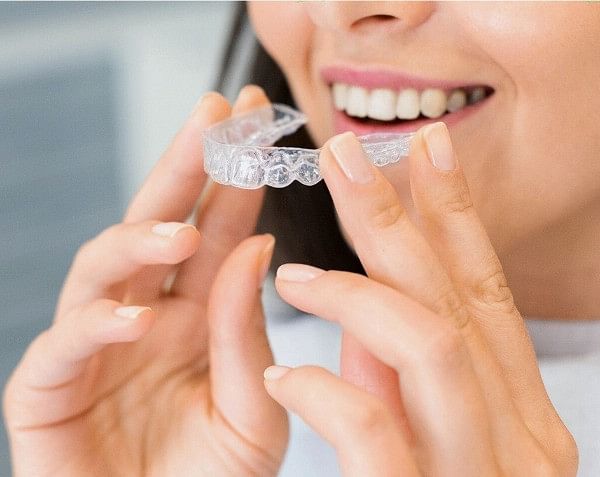For appointments, call (225) 292-6991. Serving Baton Rouge, Gonzales, Denham Springs, and New Roads

Can Invisalign Cause Headaches?
Can Invisalign cause headaches when you switch to a new tray? If your temples ache after aligner changes or your jaw feels tight by afternoon, the timing is not a coincidence. Tooth movement loads the ligaments around each tooth and wakes up the chewing muscles that stabilize your bite. Those muscles can refer to pain in the temples, especially when a tray seats unevenly or your bite hits on one side first. Here is how to tell normal, short-term pressure from a true problem and what to do today to feel better.
Short-term Headaches Can Happen When Teeth Begin Moving
Invisalign can cause short, mild headaches in the first day or two of a new aligner. Tooth movement loads the tiny fibers around each tooth, which triggers inflammation and signals your chewing muscles to stabilize a bite that is changing. Those muscles, especially the temporalis and masseter, can tighten and refer pain to the temples.
For instance, many patients describe a dull, band-like ache the evening they start a new tray, then notice clear improvement by the second or third day. The pattern is a clue. The discomfort tracks with tooth movement and fades as the tissues adapt. The takeaway: short headaches after a new tray are common and usually pass within 24 to 72 hours.

Fit And Bite Issues Are The Usual Culprits When Pain Lingers
Headaches that persist often point to mechanics rather than sensitivity. A tray that is not fully seated, a sharp edge irritating soft tissue, or a bite that touches on one side before the other can push your jaw into a strained position. Muscles work harder to find contact, and tension rises.
Imagine your right molars meet first in the new tray. You slide your jaw slightly to make the front teeth touch, then hold that posture through meetings and meals. The extra clenching fuels a temple headache by late afternoon.
Habits Around Tray Changes Can Turn Pressure Into Pain
Small routines make a big difference. Starting a new tray first thing in the morning means you feel peak pressure during your busiest hours. Dehydration from coffee, low water intake, or strenuous workouts tightens muscles further. Chewing gum or hard snacks on day one invites clenching on sensitive teeth.
One simple switch helps many patients. Change to the new aligner at night after brushing. You sleep through the strongest pressure window, then wake with a bite that has already settled a notch.
5 Simple Steps That Usually Reduce Invisalign Headaches
A few focused tactics calm the system while teeth move. Most require minutes, not hours:
- Change to each new tray at night, then wear it straight through the first eight hours of sleep.
- Seat trays fully with chewies or a bite wafer for five to ten minutes, focusing on any stubborn areas.
- Drink more water than usual on change days, and choose softer foods for the first twenty-four hours.
- Use a warm compress and gentle jaw stretches, and consider an over-the-counter pain reliever as directed by your physician.
- Call for an aligner adjustment if an edge feels rough or a tray never seems to seat; dental wax can help until you are seen.
For example, a patient who added chewies twice a day and moved tray changes to bedtime reported headaches dropping from three days to a few hours.
Not Every Headache Comes From Invisalign
Headaches have many triggers. Sinus pressure after a cold, eye strain from long screen time, and caffeine changes can mimic aligner discomfort. Preexisting clenching during sleep, also called bruxism, may continue under trays and even feel more noticeable.
Consider context. If a headache arrives with nasal congestion or follows a week of late nights at work, the aligner is likely not the primary cause.
Red Flags That Mean You Should Be Seen
Certain patterns call for an orthodontic check rather than watchful waiting. Pain that stays moderate to severe beyond seventy-two hours after a new tray, unilateral headaches near one ear, jaw clicks with pain, or a jaw that locks open or closed point to mechanics that need correction. A tray that rocks, cracks, or consistently leaves a gap around specific teeth also matters.
Picture hearing a sharp pop near your left joint when chewing, followed by a focused ache in front of the ear. That is not a “ride it out” situation.
Self-Care That Supports Your Jaw While You Straighten Your Teeth
Muscles thrive on steady habits. Keep screens at eye level to prevent jaw and neck tension, especially during laptop work. Set a reminder to unclench and rest your tongue lightly on the palate with teeth apart for a minute every hour. Hold exercise intensity on change days if heavy lifting tends to trigger clenching. Sleep on your back or side with a supportive pillow that keeps your chin neutral rather than tucked. For instance, moving a home monitor six inches higher reduced one patient’s afternoon clench without any change to the aligner schedule.
When Medical Care Beyond Orthodontics Is Wise
Migraine history, vision changes, recent head injury, fever with facial pain, or new neurological symptoms fall outside typical aligner discomfort. Those situations need your physician or dentist involved. We coordinate when needed and adjust orthodontic forces to keep you comfortable while other causes are treated.
As a practical example, patients recovering from a sinus infection often pause a planned tray change for several days until pressure resolves.
Take The Next Step With Confidence
If your aligners are triggering headaches, schedule a brief comfort check with Frugé Orthodontics. Bring your current trays and the next set. We will verify fit, balance your bite, adjust edges if needed, and map a change routine that fits your day. A fifteen-minute visit can clarify the cause and give you a clear plan for the next trays.
